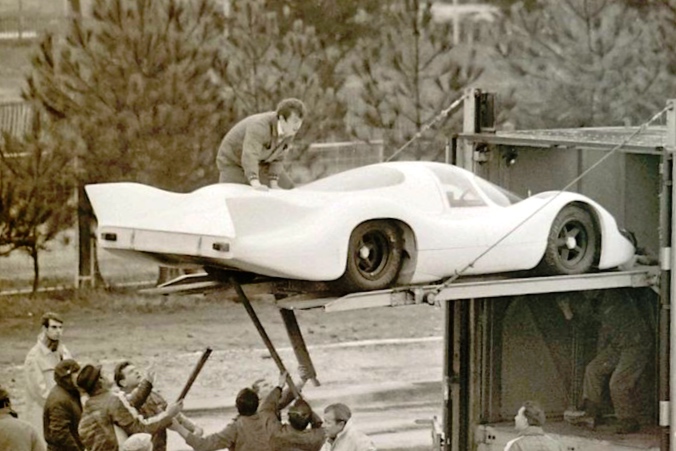|
Master EcoModder
Join Date: Jul 2011
Location: Ann Arbor, Michigan
Posts: 4,214
Thanks: 145
Thanked 2,827 Times in 1,983 Posts
|
Pilotes Anciens: June 2015

Quote:
A 1:5 model of the 917 as tested in various configurations in the SERA wind tunnel in February, 1969, two months before the 917 was homologated by the FIA.......
For Porsche, LeMans had always been the crown jewel of the World Sports Car Championship. While the 917 was built to contest the Championship, a LeMans win was as just as important. And the key to winning LeMans was high sustained speed down the four-mile Mulsanne Straight. The key to that was low drag. So the 917's shape was copied from the very successful 907 (2-liter) and 908 (3-liter) long tail cars.
Even as Porsche was testing a 1:5 (and later a 1:1) model of the 917 in the Stuttgart wind tunnel, the 1:5 model was sent to SERA in February, 1969. For stability, Deutsch suggested (and tested) a tall dorsal fin like a jet airliner's tail. He also suggested two smaller fins (as shown in #4 above). A tail configured like the 908 LH's, as used at LeMans later that year, was also tested (as shown in #3 above). None of these configurations showed a conclusive advantage in the wind tunnels. And, while the 917 LH was homologated with the 908 LH-like tail, it remained aerodynamically unstable throughout 1969.
The key to the 917's aero stability was at the rear, and was unlocked with the Horsman K tail (at the Zeltweg test) and a large wing across the full width of the LH tail (in the spring of 1970).
|
Monday, July 2, 2012
A Long Tale of Many Tails
Pilotes Anciens: A Long Tale of Many Tails

Quote:
So here is the story of the 917's tail, based on my own reading and picture research. ...........
In testing it quickly became clear that the 917 was unstable at racing speeds. But the source was not conclusively identified as aerodynamic lift until after the 1969 season was over. Both the short and long tailed cars suffered. It was capable of 190-220 m.p.h., 20% (or more) faster than a 908. The Ford GT-40, the first racing sports car to run 400+ horsepower, had suffered from aero instability too. Ford solved the problem with a rear spoiler and a blunt nose. With power to spare, higher drag was a price Ford was prepared to pay. But the Porsche Way, going back to the 356 road car--the first Porsche ever--was low drag. A "barn door" solution was not going to come from Stuttgart.
|

Quote:
Instead, he says, he noticed that while the fronts and windshields of the test coupes were covered with dead gnats, there were none on the rear spoilers. He concluded that air was not flowing to or over them. Wyer felt so strongly that Horsman had been denied proper credit for the breakthrough that he said in his memoir that the revision should be called "the Horsman Tail,"not named after him and his team. .................
Horsman says in his memoir that he was afraid that his idea would be stopped cold by Porsche's racing management because it was high drag and "Not Invented Here." So, toward the end of the test day, he took pains to casually ask if his mechanics might borrow a coupe and some sheet aluminum. This was the modification Horsman came up with:
|
Quote:
|
Which brings us to where we came in. The 917 was a bridge between the eras of streamlining (imagined or wind-tunnel tested) and modern aero downforce. It was the big power of the 917 (compared to what had come before), combined with its low drag, that forced a search for stability before aerodynamic instability was fully understood. John Horsman's "grand piano with the top up" was inelegant engineering. But it created a beautiful car: a visual feast of mechanical bits to go with the sound of the flat-12 engine.
|
Tuesday, January 5, 2016
SERA And The Porsche 917, Part Two
http://pilotesanciens.blogspot.com/2...-part-two.html

Quote:
This could be unloading for either of the two Langheck tests at the Volkswagen proving grounds, or for the LeMans
Test Days in April. In any event, the car as seen here is the "first cut" at a 1970 LH. Note the smaller rear window
without louvers. For reasons unrelated to LH aero, 1969's side exhausts for the front cylinders have been lost in
favor of conventional 6-into-2-into-1 exhausts exiting at the rear. SERA was heavily involved in this shape.
|
__________________
George
Architect, Artist and Designer of Objects
2012 Infiniti G37X Coupe
1977 Porsche 911s Targa
1998 Chevy S-10 Pick-Up truck
1989 Scat II HP Hovercraft
You cannot sell aerodynamics in a can............
Last edited by kach22i; 03-21-2018 at 07:39 PM..
|